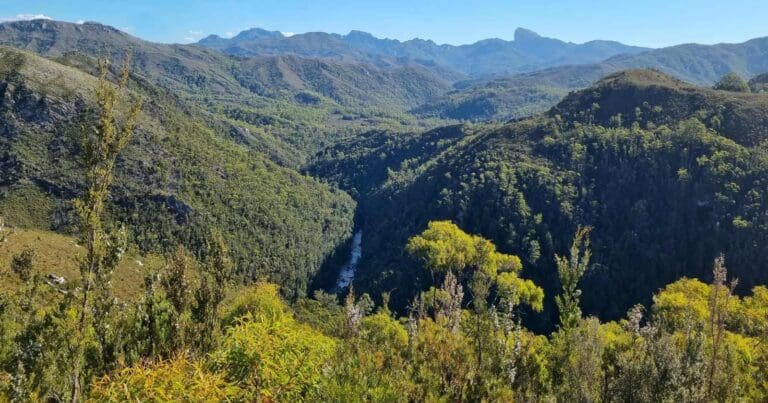Hike at a Glance
Max elevation: 387m
Min elevation: 332m
Total Ascent: 65m
Hike overview
A delightful short walk from the Lyell Highway the last between Derwent Bridge and Queenstown takes visitors alongside a burbling river to the beautiful Nelson falls. The mossy forest, featuring sassafras, myrtle and a variety of ferns, gives hints of the high rainfall in this area. These falls are always a wonderful sight, but can be a spectacularly roaring torrent after heavy rain. Return via the same track.
Along the boardwalk to Nelson Falls you will come across interpretation panels highlighting the ancient plants you see along the way, including at least seven species of fern. These interpretation panels will take you on a journey back in time to when Tasmania was a part of the great supercontinent of Gondwana.
Among the forest trees you will discover ancient species that once dominated the Australian landmass, but are now confined to the wetter regions of Tasmania and south-east and eastern mainland Australia. Many of the species of these cool temperate rainforests are only suited to the cool, moist conditions of places such as the Nelson Valley.
Content use
Please don’t copy GPX files or content from this site to AllTrails or other platforms. Each trail has been personally mapped, documented, and refined to support Australia’s bushwalking and hiking community. While some details come from land managers, every listing reflects significant personal effort. This is a free, community-driven initiative—your respect helps keep it that way.
Walk map and GPX file
Max elevation: 387 m
Min elevation: 332 m
Total climbing: 65 m
Total descent: -65 m
Getting there
Getting to the trailhead: Franklin-Gordon Wild Rivers National Park.
The Lyell Highway (A10) connects Hobart in the south-east of Tasmania with Queenstown in the west. It runs through the Franklin-Gordon Wild Rivers National Park.
From Hobart, travel west for 2.5 hours via the Lyell Highway. From Launceston, travel south via Longford and Poatina on the Highland Lakes Road (A5) to Miena and the B11 to Bronte Park. Join the A5. King William Saddle, west of Derwent Bridge, marks the eastern boundary of the park. A further 56 km along the highway, Nelson Falls marks the western boundary, a 3 hour drive from Hobart.
The park can also be accessed via the lower Gordon River on one of the daily cruise boats from Strahan.
The Lyell Highway may occasionally be closed by snow in winter.
Where possible, please avoid driving in our reserves at night. You are sharing the roads with our native wildlife, so take it slow and watch out for animals on the road.
Closest towns to this walk: Derwent Bridge, Hamilton, Macquarie Plains, Maydena, Mount Field, Ouse, Queenstown, Rosebery, Strathgordon, Tullah, Tyenna
About the region
Franklin-Gordon Wild Rivers National Park, located in western Tasmania, offers a dramatic landscape of rugged mountains, deep gorges, and pristine rivers. The park, situated approximately an hour’s drive from Strahan, is part of the Tasmanian Wilderness World Heritage Area. The Lyell Highway provides convenient access to short walks with scenic views of the Franklin River, while cruises from Strahan explore the impressive Macquarie Harbour and Gordon River.
The park is historically significant for its role in the major conservation battle of the 1980s, which successfully protected the Franklin River from hydro-electric development. With more than 1900mm of annual rainfall, the park features lush vegetation, including wet temperate rainforest, buttongrass moorland, and eucalypt forest. This diverse environment supports a range of native wildlife, including the Tasmanian devil, spotted-tail quoll, and platypus.
The park also holds cultural importance with several Aboriginal sites, reflecting the southernmost extent of human occupation during the last ice age. The colonial history includes the grim penal settlement on Sarah Island and convict logging operations, which lasted over 150 years. The old Linda Track and the Lyell Highway were crucial for accessing the region’s resources.
To visit, drive west from Hobart for about 2.5 hours via the Lyell Highway or take a cruise from Strahan. Note that the highway may be closed due to snow in winter.
Want to find the best tracks and trails for an adventurous hike, casual walk, or a family trip? Trail Hiking Australia has the best trails for walking, hiking, running, and more.
Similar walks nearby
Looking for more walks in or near Franklin-Gordon Wild Rivers National Park? Try these trails with a similar difficulty grade.
Track grade
Grade 2 (Easy) - A Gentle Introduction to Inclines: Grade 2 on the AWTGS represents easy walking tracks that offer a slightly more challenging experience compared to Grade 1. Similar to Grade 1, no prior bushwalking experience is required. The track surface is typically hardened or compacted and may have gentle hill sections or occasional steps. The total distance of a Grade 2 walk is typically no greater than 10 kilometers. These walks are still suitable for families with a bit more experience or those seeking a gentle introduction to some inclines.
Explore safe
Plan ahead and hike safely! Carry enough water, pack layers for changing conditions, and bring safety gear like a torch, PLB, and reliable communication device. Check official sources for trail updates, closures, and access requirements, and review local weather and bushfire advice. Most importantly, share your plans with someone before you go. Being prepared makes for a safer and more enjoyable hike! Stay Safe, Explore More, and Always #ExploreSafe.
Packing checklists
What you carry in your pack depends on factors like weather, terrain, and your adventure type. Not sure what to bring? My free planning, food, and packing checklists are a great starting point, covering day hikes, overnight trips, and multi-day adventures. Use them to customise your kit and always prioritise safety.
Let someone know
Before heading out, take a moment to fill out your trip intentions form. It’s a quick way to share your hike details with family or friends. If something goes wrong, they can notify emergency services, ensuring a faster response and peace of mind. Stay safe and enjoy your adventure
Suggest an edit
Spotted a change on this trail? Maybe there are new features, the route has shifted, or the trail is permanently closed. Whatever the update, I’d love your input. Your feedback helps fellow hikers stay informed and ensures that our trail info stays fresh and reliable.
Acknowledgement of Country
Trail Hiking Australia acknowledges the Traditional Owners of the lands on which we hike and pay respects to their Elders, past and present, and we acknowledge the First Nations people of other communities who may be here today.
/Nelson-Falls-Walk_2.jpg)
/Nelson-Falls-Walk_6.jpg)
/Nelson-Falls-Walk_1.jpg)
/Nelson-Falls-Walk_3.jpg)
/Nelson-Falls-Walk_5.jpg)
/Nelson-Falls-Walk_4.jpg)






